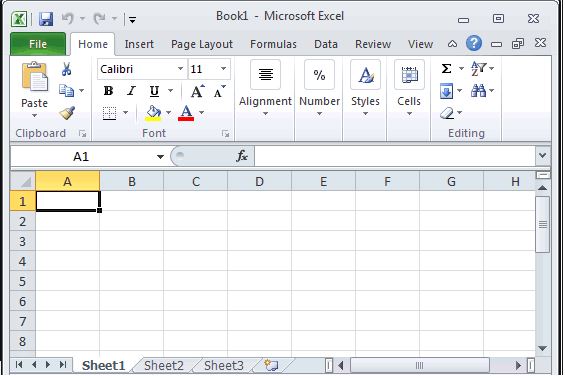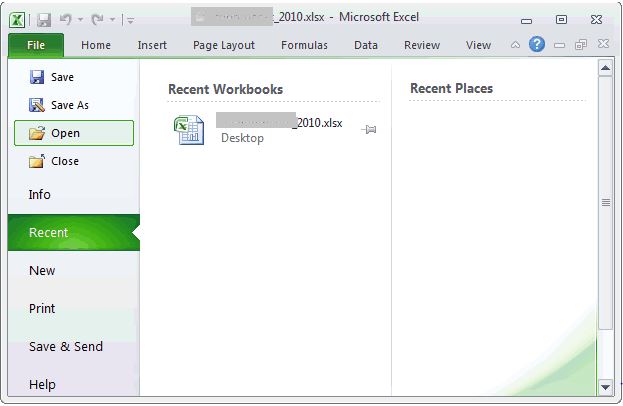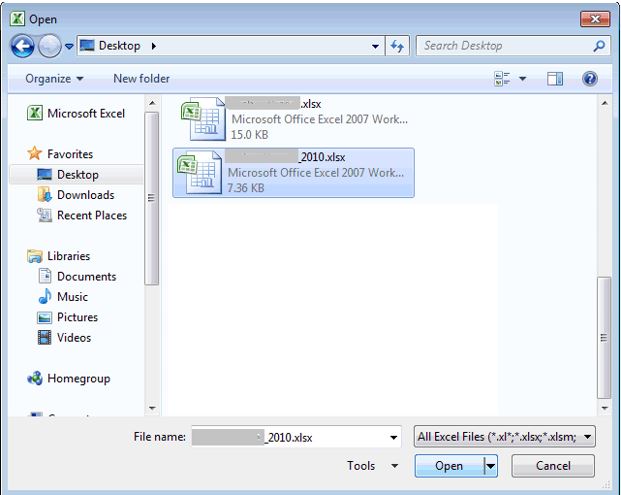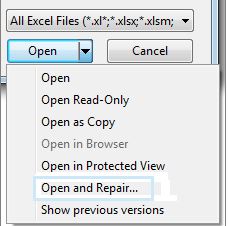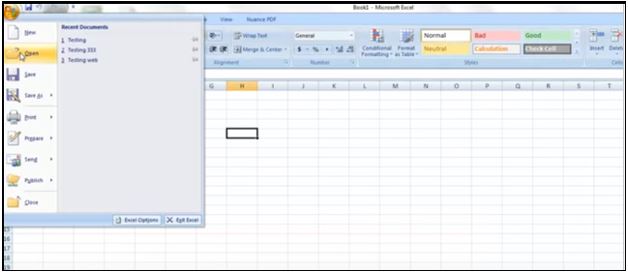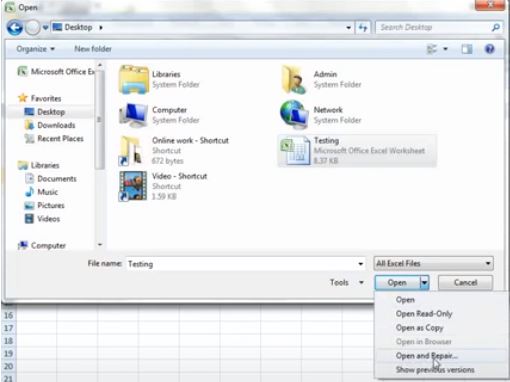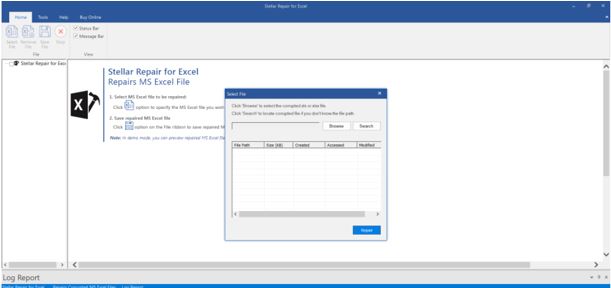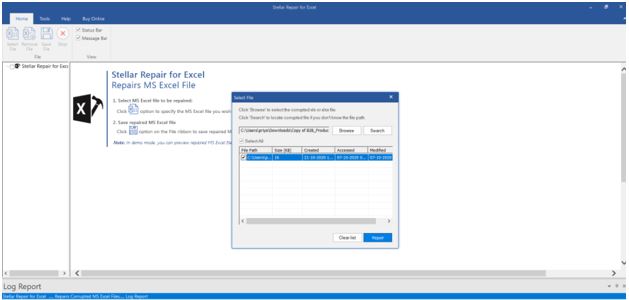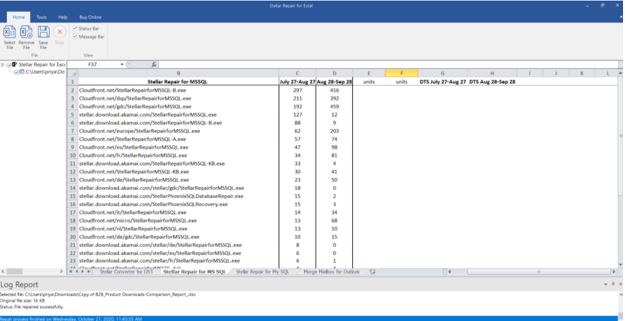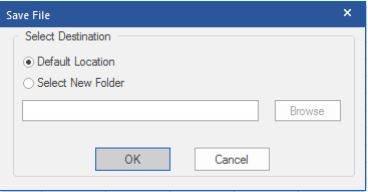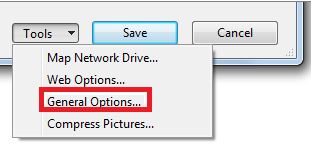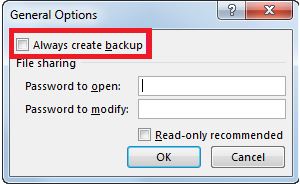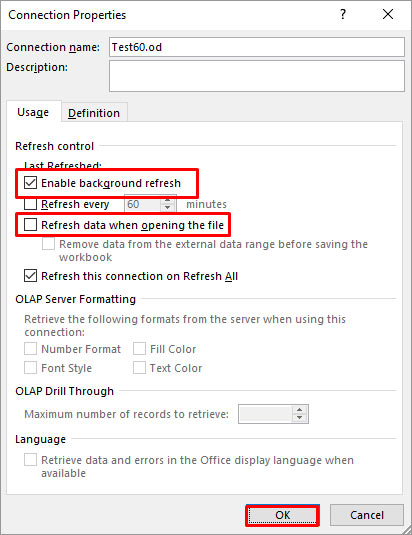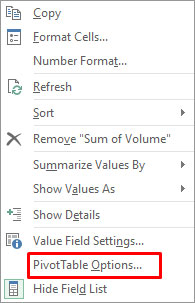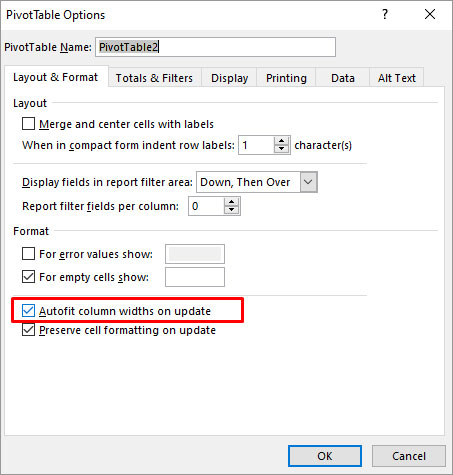
Ways to Fix the Failed to Parse the Corrupted Excel 2023 File Error | Stellar

Ways to Fix the “Failed to Parse the Corrupted Excel File” Error
Summary: While parsing an Excel file, you may experience the “Failed to parse the corrupted Excel file” error. It usually occurs if the Excel file is corrupt. This blog covers some easy fixes to fix this Excel error. It also mentions an advanced Excel repair tool that can help fix the issue by repairing the corrupted file.
You may encounter the “Failed to parse the corrupted Excel file” error when parsing (extracting or converting) the data in an Excel file. This error usually occurs if the Excel file is corrupted – either completely or partially (some of its objects, like formulas, macros, and values are corrupt). However, there are various other reasons that may lead to this Excel error. Let’s know the possible causes behind the “Failed to parse the corrupted Excel file” error and how to fix it.
Causes of the “Failed to parse the corrupted Excel file” Error
This error could occur due to any of the following causes:
- Damaged or corrupted macros
- Excel document is closed suddenly
- Issues with Excel application installation
- Virus or malware attack
- Hardware failure
- Bad sectors on the hard drive
Ways to Fix the “Failed to parse the corrupted Excel file” Error
Here are some possible ways to fix this error and recover the Excel file.
Method 1: Try to Save the File in a Different Format
Sometimes, the error can occur if the file format is not compatible with your Excel version. You can try saving the file to a different format. To do this, follow the below steps:
- Open the Excel file.
- Click on the File option and then select Save As.
- Click on Browse option and then click Save as Type.

- Select the desired Excel file format and click Save.
Method 2: Revert to the Previously Saved Version of the Excel File
You can try reverting to the previously saved version of the Excel file. Here’s how:
- Open your Excel application.
- Navigate to File > Info > Manage Workbook.

- Click Recover unsaved workbooks.

- Click on the Restore option you see at the top of the file.
Method 3: Set the Calculation Option to Manual
When the calculation mode is set to automatic, Excel automatically recalculates all the formulas in the file even if you make a minor change. It can take time to load the file and stop you from parsing data in your Excel file. You can change the calculation option to manual so that Excel only recalculates when you explicitly tell the application to do it. Here are the steps:
- Open your Excel application.
- Navigate to File and then click Options.
- In Excel Options, select Formulas.
- Under Workbook Calculation, select Manual and click OK.

Method 4: Use Open and Repair Utility
You can try repairing the corrupted Excel file with Excel’s inbuilt tool – Open and Repair . To use the tool, follow the steps cited below:
- In Excel, go to the File tab and then click Open.
- Click Browse to select the corrupted file.
- The Open dialog box will appear. Click on the corrupted file.
- Click on the arrow next to the Open button and then click Open and Repair.
- You will see a dialog box with three buttons Repair, Extract Data, and Cancel.

- Click on the Repair button to recover as much of your work as possible.
- After repair, a message will appear (as shown in the below figure).

- Click Close.
What If None of the Above Methods Works?
The above methods may fail to work if the Excel file is severely damaged. In such a case, we recommend using an efficient Excel repair tool , such as Stellar Repair for Excel. It can quickly repair corrupted Excel (.XLS/.XLSX) files. It can recover all the objects from the file, including charts, tables, formulas, etc. You can download the free trial version of the tool to preview the recoverable data.
Conclusion
Above, we have discussed some tried and tested methods to fix the “Failed to parse the corrupted Excel file” error. If the Excel file is severely damaged or corrupted, you can try repairing it using a third-party Excel repair software, like Stellar Repair for Excel . It can repair multiple Excel files without affecting the original formatting. The tool is compatible with all Excel versions.
How to Fix a Corrupted .xls File? The Everything Guide
Undoubtedly, Excel is so powerful that it can help you to process, analysis, and store data, in masses.
That’s the reason it has been there for years and helping this world in data.
But…
With all those powers comes some nasty problems which no Excel users like to face. Can you guess what I’m talking about?
Think about a Corrupted Excel File. Nightmare? Isn’t it?
And do you remember that last time when you have opened a workbook and you got a message that this workbook is might corrupt?
The TRUTH is, this is something which you cannot avoid, but, you can prepare yourself in the best way and deal with it like a PRO.
So today, in this post, I’d like to share with you to everything you need to know about a corrupt Excel file (.xls), why it happens, how to fix it like a PRO, and much more.
…let’s get started.

Note: In this post, we’ll be covering the .xls version (which is the extension for the file which is created in Excel 2007 or the earlier versions) and if you want to know about the new version, here’s the quick fix for that.
Why My Excel File Got Corrupted?
There can be one or multiple reasons for an Excel file to get corrupted. Below I have detailed about some of the major of them.
1. Large Excel File
You can store data in a workbook the way you want but sometimes using excessive thing can make an Excel file bigger in size.
And that kind of data files can crash at any point in time. Here are a few things which make the Excel files heavy, like
- Conditional Formatting.
- Colors formatting.
- Using merged cells in place of text alignment.
- Volatile functions: Formulae that iterate every time you open or change a cell value; OFFSET, NOW.
- Using a complete column or row as a reference than the data set range.
- Using complex formulas; VLOOKUP in place of Index/Match, Nested If in place of MAXIFS, MINIFS.
- Calculations or reference across workbooks.
Related: How to Fix Formatting Issues in Excel
2. Abrupt System Shutdown
Shutting down the system without following the procedure can corrupt your data file.
This shut down can be due to a power failure or any other unexpected technical challenges.
So it is always important to follow the procedures and shut down your system properly to avoid data losses.
3. Infected Excel File (Virus Attack)
This is the most common and obvious reason for Excel file corruption.
Although we always keep our system safe using various Antiviruses, still there is always a probability of virus attacks and loss of important files.
It is always advised to use a safe and strong antivirus compatible with your system requirements.
What are the Signs to Know When an Excel File is Corrupted?
In this section, we will discuss what are the signs which you can get when an Excel file is corrupted, let’s dig into it.
1. The File is Corrupt and Cannot Be Opened
This is one of the most common messages you can see when your workbook is corrupted.
But there is also a chance that it is just because of the version compatibility where you have a .xls file but you are using the latest version of Excel check out this detailed post by Priyanka
2. We Found a Problem with some Content in this File…
There’s another error message which you can get while opening a file:
We Found a Problem with some content in Do you want us to recover as much as we can? If you trust the source of this workbook, click yes.

There are a lot of applications out there (I think almost every) which exports the data as a .xls format. Those files have a greater chance of having this kind of error.
3. “Filename.xls” cannot be accessed
There can also be a situation where you get the error:
“Filename.xls” cannot be accessed. The file may be corrupted, located on a server that is not responding.
Well, this message is a bit misleading.
You won’t be able to decide that your file is actually corrupted or just not on the location.
My Excel File Got Corrupted, now What Should I Do?
There are many ways to recover the data from the corrupt excel files. But before you start, it is always advised to create a copy of the corrupted file.
You can save a lot of time with Stellar Repair for Excel, which make data recovery just with few clicks.
But before you go for a data recovery software, let’s try out some manual steps which can help.
When a workbook get corrupted the first thing comes to the mind is to recover data from it…
…and you what there’s a simple option there in the Excel which you can use to do this. Below are the steps you need to follow:
- First of all, open the Excel and click on the office icon.
![]()
After that, go to the “Open” and select the file which is corrupted.
Now, click on the open drop-down and select “Open and Repair”.
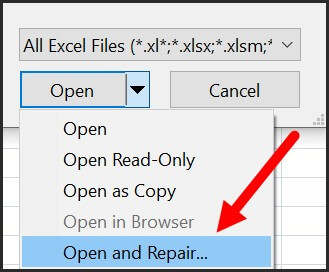
- At this point, you have two options:
- Repair File
- Extract Data

Let’s get into both of these options one by one…
1. Repair File
This option helps you to repair the file and the moment you click on it it takes a few seconds afterward and shows you the result with a message box and also provide you a log file.
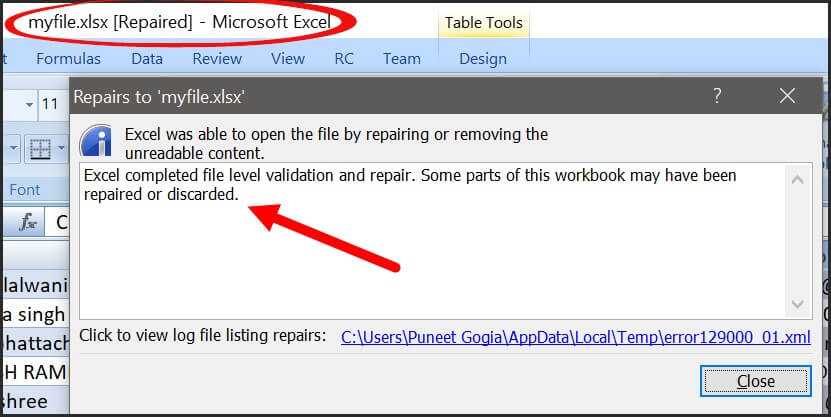
And once it is done with repairing, you’ll get your file opened and you can save that file as a new copy.
Yes, that’s it.
2. Extract Data
If somehow you aren’t able to get your file repaired, you can also extract data from that file using “Extract Data” option.
Even in this option, you can get data in two ways.

- As Values
- With Formulas
In the first option, Excel simply extracts data as value ignoring all the formulas driving those value (which is the best way if you just need to have that data back ).
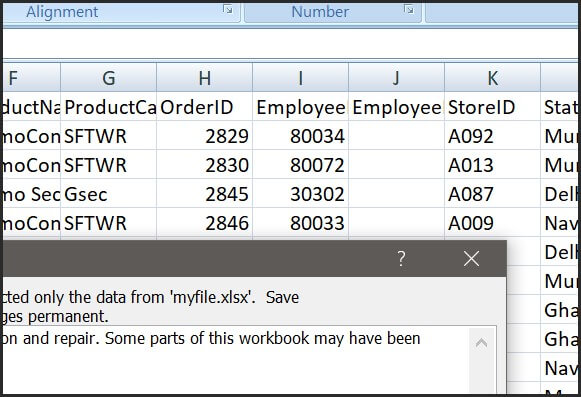
But in the second option, Excel tries to recover the formulas as much as possible.
Check out this smart technique by Jyoti which you can use it you aren’t able to recover data from the file.
Preventions to Not to have any Excel File Go Corrupt in Future
Future is fragile, what I’m trying to say is the more you work in Excel and process data there could be a chance that your workbook goes corrupt.
If there’s no security then what an EXCEL POWER user should do?
Well, there are few things which you can do or take care of while working with Excel so that you won’t have to worry about corruption of Excel workbooks.
Let’s see what you can do…
1. Change Recalculation Option
Now here’s the thing when you work with a hell lot of data, there a common thing that you gotta using formulas. Right?
But, the thing these formulas are something which makes your Excel file slows down sometimes make them go corrupt.
There’s one small tweak you can do in your workbook is change the calculation method.
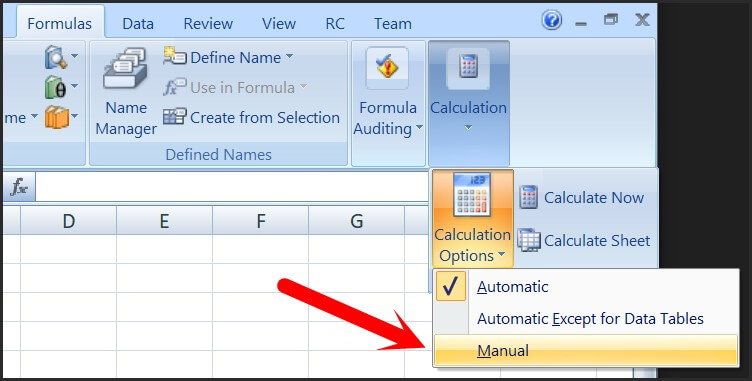
Now with the manual calculation, you just need to whenever you open your file it won’t recalculate all the formulas.
And when you update your data you can simply click on the “Calculate Now” and it will calculate all the formulas again.
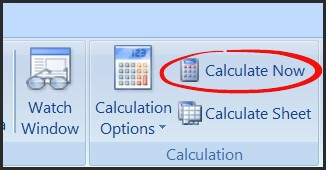
Quick Tip: Beware of Volatile Functions and use them with caution as recalculates them every time you change something in the worksheet.
2. Use VBA Codes Instead of Formulas
Now, this is what I do when I need to use complex formulas in a workbook.
Here’s how you can do this: Let’s say you have a formula in the cell A1, like below, which calculates the age.
=“You age is “& DATEDIF(Date-of-Birth,TODAY(),”y”) &” Year(s), “& DATEDIF(Date-of-Birth,TODAY(),”ym”)& “ Month(s) & “& DATEDIF(Date-of-Birth,TODAY(),”md”)& “ Day(s).”
Now, instead of simply entering it into the cell A1 which I would write a macro code which inserts this formula into the cell A1 and then convert it into the a value.
Here’s the code:
Sub CalculateAge()
Range(“B1”).Value = _
“=””Your age is “”” & _
“&DATEDIF(A1,TODAY(),””y””)” & _
“&”” Year(s), “”” & _
“&DATEDIF(A1,TODAY(),””ym””)” & _
“&”” Month(s), and “”” & _
“&DATEDIF(A1,TODAY(),””md””)” & _
“&”” Days(s).”””
Range(“B1”) = Range(“B1”).Value
End Sub

Note: To write these code you need to have basic understading of VBA (make sure check out this guide for this).
3. Use a File Recovery Application
Recently we asked a quick question to our readers on ExcelChamps that if they have ever faced a situation where they got a corruption message in Excel.
You’ll be astonied to hear that 50% percent of the people said “YES” they faced this thing in the past.

Now, this is alarming, if you are heading a team or you have a bunch of people in your company who use Excel…
…there’s a high probability that half of them gonna face this issue. So the best way to deal with this to have an App FIX your Excel file for you.
With STELLAR REPAIR FOR EXCEL, you just need a few clicks, yes that’s right. Let me show you with the below steps:
- First of all, download the app and install it (it’s simple).
- After that, open the app and click on the “Browse” and simply select the file which is corrupted.
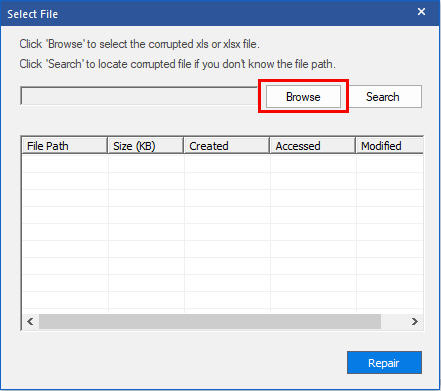
- In the end, click on the REPAIR to let the Excel repair software fix your file (it takes a few seconds).
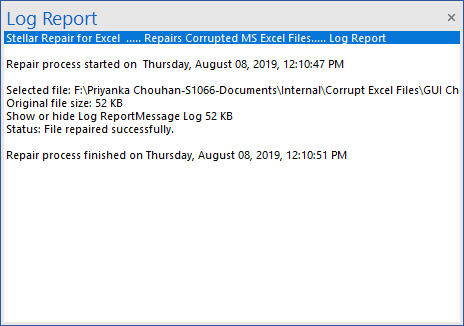
Once you complete repairing your file, you’ll get a message in your on the status bar and after that, you can open your file.
Final Thoughts
If you are a POWER Excel user then there’s a must for you to have known how to deal with a situation where you got a corrupt Excel file.
But I must recommend you to TRY OUT Stellar Repair for Excel so that’s you don’t have to worry about your Excel files anymore.
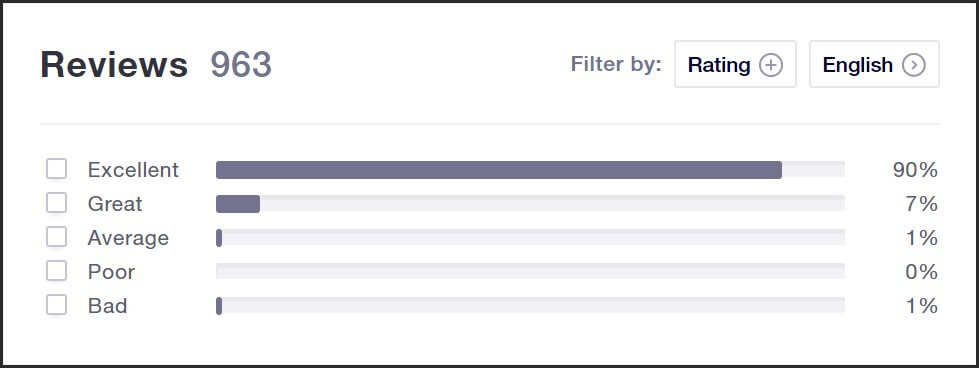
I’m sure you found this post helpful, and please don’t forget to share this tip with your colleagues, I’m sure they’ll appreciate it.
Recover Corrupted Excel File 2007, 2010 | Easy Methods
There are several reasons that can cause Microsoft Excel workbooks to turn corrupt, such as virus attack, bad sectors on a drive on which Excel file is saved, system shutdown without properly closing the Excel application, etc.
Corruption in an Excel workbook can result in data loss or render the workbook inaccessible. Fortunately, Excel automatically starts recovery upon opening a corrupted Excel file. But, if it fails, you can manually repair the file or extract data from the corrupt file.
Quick Solution: Performing 2007, 2010 Excel repair or recovery process manually can be time-consuming. Also, manual workarounds to recover corrupt Excel workbook does not guarantee recovering the complete workbook data. Use Stellar Repair for Excel software to repair single or multiple Excel (XLS/XLSX) files in 3 simple steps. The software also helps recover the Excel file, keeping the data intact.
.jpg)
How to Fix Microsoft Excel 2010 & 2007 Files Corruption?
Microsoft Excel comes with an inbuilt repair utility, called ‘Open and Repair’, that helps fix and recover corrupted Excel files.
Steps to Repair MS Excel 2010 Files Manually
The detailed steps to open and repair Excel 2010 are as follows:
- Open Microsoft Excel 2010 and click File from the main menu.
- Next, click Open.
- Browse the corrupt Excel 2010 file on your computer and select it in the Open dialog.
- Click the arrow next to the Open button and choose Open and Repair.
- Click Repair when prompted to recover data to the maximum.
- If Excel fails to repair, click Extract Data to extract values and formulas in the corrupt file.
- Excel prompts to ‘Convert to Values’ or ‘Recover Formulas’.
- Click Yes if it prompts the following error:
“The document file name caused a serious error the last time it was opened. Would you like to continue opening it?
- When Excel opens the last saved file, save it.
Once you’re able to access the last saved 2010 Excel file, try extracting the file contents.
Save Excel 2010 File in HTML Format
If you can open the Excel file, choose the HTML format to save it in filtered form. After that, close the Excel file as you have your data in the HTML file. The steps to save an Excel file in HTML format are as follows:
- Open Microsoft Excel 2010, click Save As, and then choose Web Page in the ‘Save as’ type drop-down list.
- Select the “Enable Entire Workbook” option, and then click the Save button.
- Close the Excel file and reopen your Microsoft Excel application. Browse the HTML file that you have saved.
- Click File from the main menu, and select Save As in the list.
- Type-in a different name, choose Microsoft Excel Workbook in the ‘Save as’ type drop-down menu, and then click the Save button.
With this, you would be able to access the data in the corrupt Excel file.
If the inbuilt tool fails to repair Excel 2010 file, a few methods can help you recover data from corrupted or lost workbook manually.
Steps to Repair Excel 2007 Files Manually
Follow these steps to repair a corrupted 2007 Excel file by using the inbuilt Microsoft Excel repair tool:
- Open Microsoft Excel 2007, click the Office button, and then select Open.
- In the Open dialog box that pops-up, browse and select the corrupt Excel 2007 file. Click the arrow next to the Open button and choose Open and Repair.
- Click Repair when prompted to recover as much data as you can from Excel 2007 file.
- If a repair fails, follow steps 1 till 3, and then click Extract Data to extract values and formulas from the corrupt file.
- In the window that appears, click Convert to Values or Recover Formulas to extract workbook data.
Note: The built-in Microsoft Excel 2007 repair tool may fail to resolve Excel corruption issue. Also, choosing to extract data from the workbook involves data loss risk. Using a professional Excel repair tool, however, can resolve all types of Excel file corruption errors and restore all its data.
Methods to Recover Data from Corrupt Excel 2010 & 2007 Files
If the ‘Open and Repair’ feature fails in getting your Excel 2010, 2007 file repaired, you can try retrieving the file contents by following some manual methods. However, the methods may vary depending on whether you can open a workbook or not.
Method 1 – Move Corrupt Excel File to another System
Move the corrupt Excel file to any other computer and try opening it in MS Excel 2010/2007. Doing so, may help you resolves disk or network-related errors leading to Excel file corruption.
Method 2 – Revert Unsaved Excel File to its Last Saved Version
If an Excel file turns corrupt while working on it but before saving any changes, try reverting it to its last saved version. To do so, perform the following:
- Open your Excel application, click the Office button, and then click Open from the menu.
- Browse the corrupt Excel file, click Yes when prompted to revert to its last saved version.
What if Nothing Works?
If you fail to recover a corrupt Excel 2007/2010 file, perform Excel file recovery with Stellar Excel repair software. The software is specially designed to help users fix their corrupted XLS/XLSX files quickly and easily without any technical assistance. It also helps restore all the file data to its original form.
Points to Remember
- Close all the MS Excel instances before using the software
- If the sheet you are repairing contains engineering formulas, please include ‘Analysis TooPak’ manually from Tools > Add-Ins
If you know the corrupt Excel 2007 or 2010 file location, click Browse to choose the file. Otherwise, click Search. Follow the below steps to recover data from corrupt Excel 2007/2010 file by using Stellar Excel repair tool:
- Click the Repair button to scan the file.
- Once the scanning process is complete, the software shows a preview of recoverable Excel file items.
- To save the repaired file, click the Save File option on File menu.
- In ‘Save File’ dialog box, choose to recover Excel 2007 & 2010 data to either the Default or New location. Click OK.
The repaired Excel file gets saved at the specified location.
Preventive Measures to Avoid Losing Excel File Data
The above-discussed methods might help salvage your data. But, it is recommended that you must take some preventive measures to avoid losing the data. One such important measure is backing up a copy of your workbook automatically. Doing so, will help you get back data in case the workbook is accidentally deleted or corrupted.
Steps to Create Backup Copy Automatically
You can automatically create an Excel backup copy by following these steps:
- Click Save As from the main menu of your Excel application.
- Browse to the location where the corrupt Excel 2010/2007 file is saved.
- In ‘Save As’ dialog box, click the arrow next to Tools button (given at the bottom left corner) and choose General Options.
- In ‘General Options’ box, check Always create backup checkbox, and then click OK.
With this, you instructed MS Excel to create a backup of every Excel file you create or open for work.
Conclusion
This article outlined the typical reasons resulting in a corrupt Excel 2010 or 2007 file, such as virus infection, bad sectors on drive, etc. It explained how to fix a corrupted Excel file by using the inbuilt MS ‘Open and Repair’ tool. The article also discussed methods to recover Excel files in MS Office 2010 & 2007 when the Microsoft Excel repair tool fails. Further, it explained how using a professional repair tool such as Stellar Repair for Excel can come in handy when the manual methods to repair and recover Excel 2007 and 2010 file fails. But, keep in mind, a workbook may get corrupt again. And so, make sure to automatically backup your workbook to avoid losing its data.
Ways to Fix Personal Macro Workbook not Opening Issue
Many users have reported encountering issues while accessing personal macro workbook, such as personal macro workbook not opening, personal macro workbook not loading automatically, Excel personal macro workbook keeps getting disabled, etc.
Such issues may arise due to a problem with the directory where the personal workbook is stored. However, there are various other reasons that may lead to such issues. Below, we’ll discuss the reasons behind the personal macro workbook not opening issue and the solutions to troubleshoot and fix the issue. But before proceeding, let’s understand why personal macro workbook is used.
Why Personal Macro Workbook is used?
You can access macros in a specific Excel workbook. However, when you need to use the same macro in other Excel worksheets, then you can create a personal macro workbook. A personal macro workbook (Personal.xlsb) is a hidden workbook that is used to store all macros. It makes your macros available every time you open Excel.
Causes of Personal Macro Workbook not Opening Issue
You may encounter personal macro workbook is not opening issue when attempting to record macros. Some possible causes behind such an issue are:
- Personal macro workbook is stored at an untrusted location
- Location of xlsb is changed
- Personal macro workbook is hidden
- Personal macro workbook becomes corrupted
- Disabled items in add-ins
- Workbook is Read-only
Methods to Fix the “Personal Macro Workbook not Opening” Issue
Follow the given methods to fix the personal macro workbook is not opening issue:
Method 1: Check the Path of Personal.xlsb
The personal macro workbook (Personal.xlsb) file is stored in XLStart folder. It opens automatically when you open your Excel application. However, sometimes it fails to load automatically. It usually occurs when you try to open the file from an incorrect path. You can check the path of Personal.xlsb by following these steps:
- Open the workbook.
- Click on the Developer tab.

- Press Alt + F11 to open Visual Basic Editor.
- Go to View > Immediate Window.
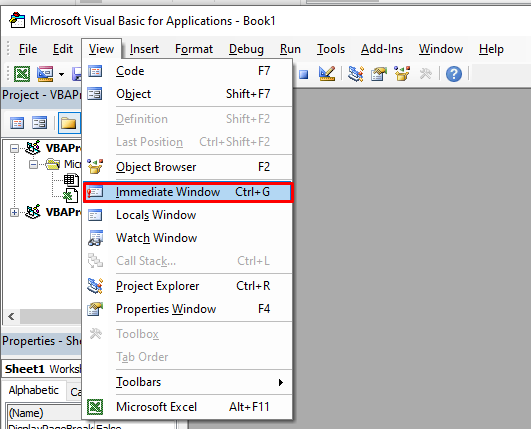
- In Immediate Window, type the following code to know the location of the workbook:
?thisworkbook.path.
- Then, hit Enter.
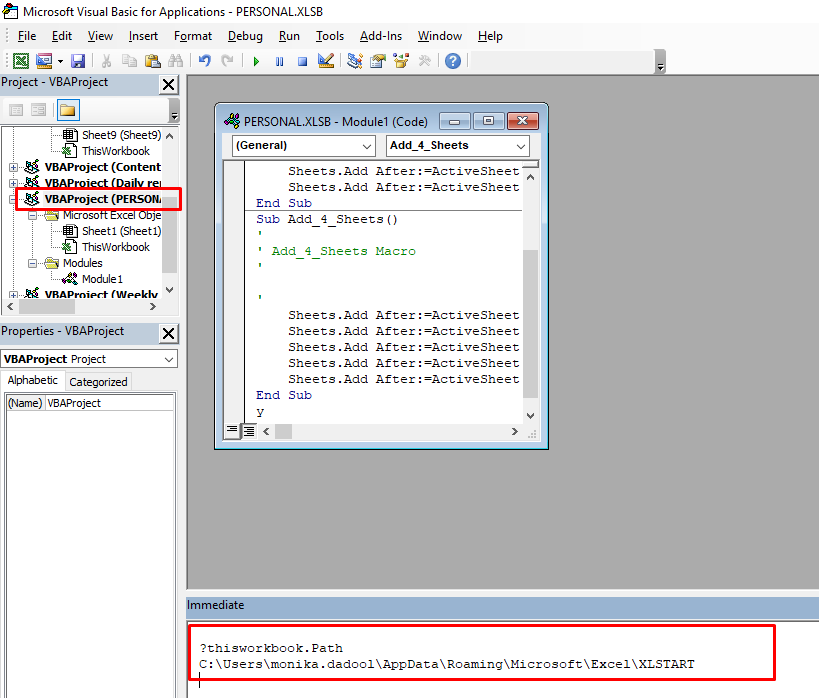
- You will see the path of the personal macro workbook.
- Copy the path and paste it into Quick Access field in File Explorer.

Method 2: Unhide Personal Macro Workbook
If personal macro workbook is hidden, you may unable to see and open the Personal.xlsb file. To unhide the personal Macro workbook, follow the below steps:
- In Microsoft Excel, go to View and then click Unhide

- The Unhide dialog box is displayed. Click PERSONAL and then OK.
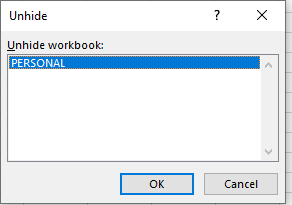
Method 3: Enable the Macro Add-ins
You may unable to open the previously recorded macros in your personal macro workbook if the macros are disabled. To check and enable the items, follow these steps:
- Go to File > Options.
- In Excel Options, click on the Add-ins
- Select Disabled Items from the Manage section and click on Go.
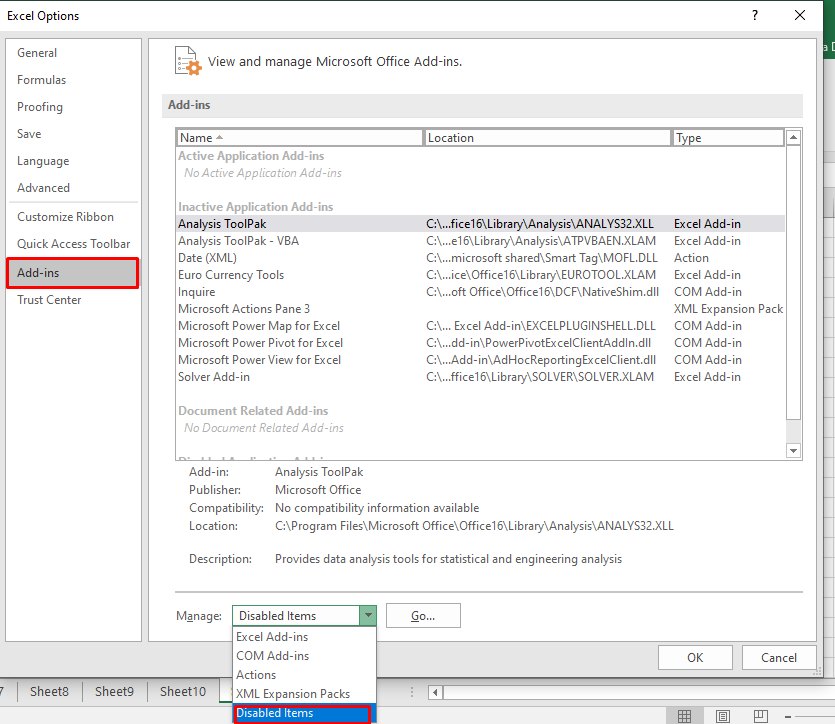
- The Disabled Items dialog box appears. Click on the disabled item and then click Enable.
Method 4: Change the Trusted Location
You may encounter the “personal macro workbook not opening” issue if the Personal.xlsb file is stored at an untrusted location. You can check and modify the path of XLSTART folder using the Trust Center window. Here are the steps:
- Open MS Excel. Go to File > Options.
- Click Trust Center > Trust Center Settings.
- In the Trust Center Settings dialog box, click on Trusted Locations.
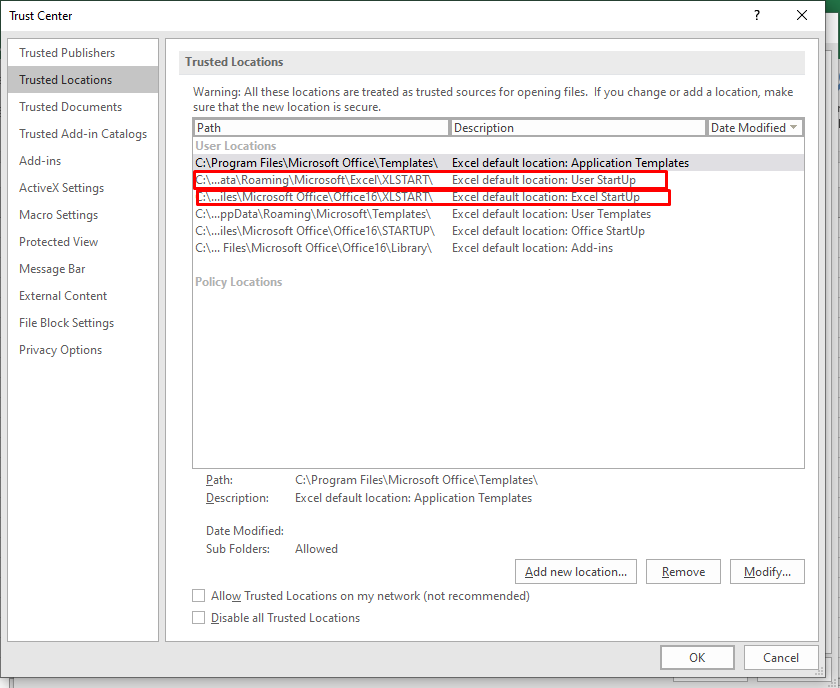
- Verify the path of the XLSTART If it is untrusted or there is any issue, then click Modify and then click OK.
Method 5: Repair your Excel File
You may fail to open personal macro workbook if it is corrupted. To repair the corrupt workbook, you can use the built-in Open and Repair utility in MS Excel. To use this tool, follow these steps:
- Open your Excel application.
- Click File > Open.

- Browse to the location where the corrupted file is stored.
- In the Open dialog box, select the corrupted workbook.
- From the Open dropdown list, click Open and Repair.
The dialog box appears with the Repair and Extract buttons. Click Repair to retrieve all possible data or the Extract option to recover the data without formulas and values.
If the Open and Repair utility fails to repair the corrupted Excel workbook, then you can use a professional Excel repair tool, such as Stellar Repair for Excel. It can easily repair severely corrupted Excel (XLSX and XLS) files and recover all the components. You can download the free trial version of the tool to preview the recoverable data.
Closure
This article discussed the ways to fix the personal macro workbook not opening issue. In case you are unable to open the personal macro workbook because of corruption in the workbook, you can use the Open and Repair utility in MS Excel. If it fails, then you can use Stellar Repair for Excel to fix corruption in the Excel file and recover all its data with complete integrity.
Repair Files using Stellar Toolkit for File Repair
Stellar Toolkit for File Repair Technician
The main interface of Stellar Toolkit for File Repair comprises four modules to repair MS Office and PDF files. These modules are:
- Repair Document
- Repair Spreadsheet
- Repair PowerPoint
- Repair PDF
Click on the desired tab to repair that file format.
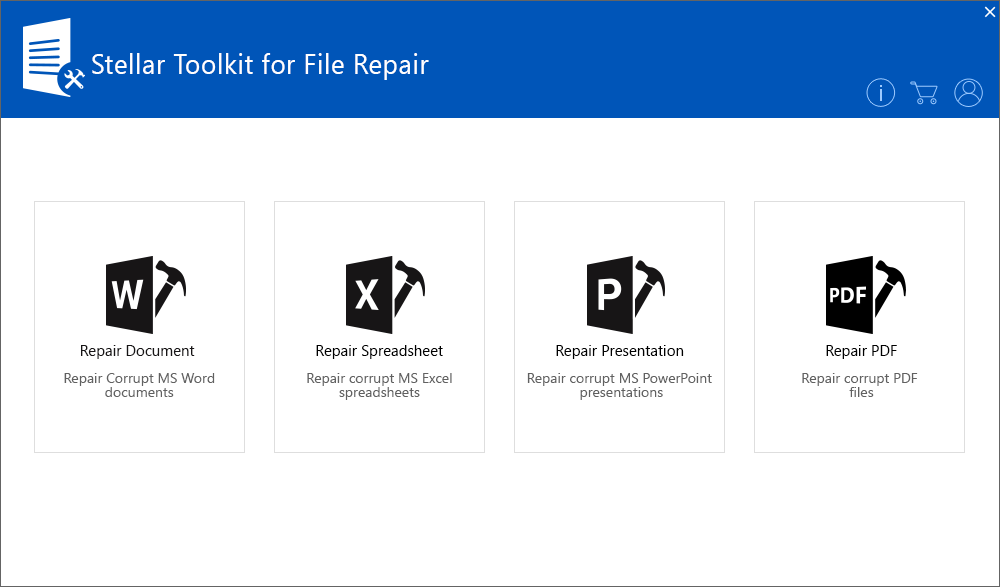
Figure 1 - Illustrates Homepage of the Stellar Toolkit for File Repair
Steps to Repair MS Word – .doc/.docx file
- Click Select File to select a single corrupt Word (.doc/.docx) file that you want to repair. Alternately, click Select Folder for selecting all Word files in a single folder.
Note: Click Find file(s) to search for the Word file, if the location is not known.
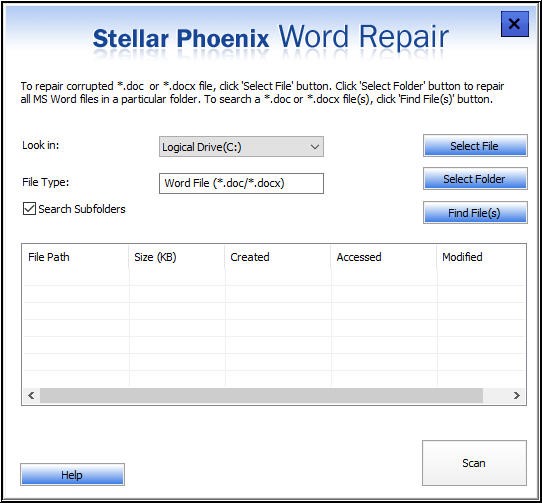
Figure 2 - Illustrates Selection of single doc/.docx file or multiple files
- Once the file is selected, click the Scan button to scan and repair the file.
- A preview of the repaired Word file is displayed on the screen. Verify the file contents from the right pane of the preview window.
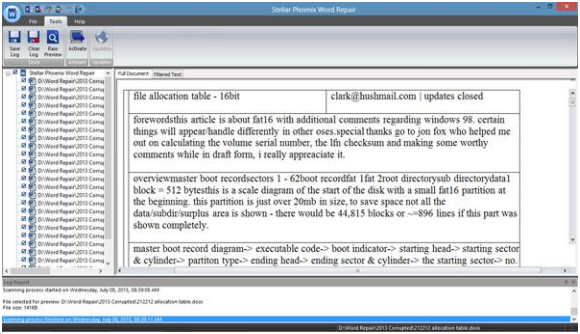
Figure 3 - Preview of Repaired Word Document
Note: If you’re unable to repair a corrupt .doc file, select ‘Advance Repair’ option from the File menu for repairing the .doc files.
- Click the Save icon on the File menu to save the repaired file.
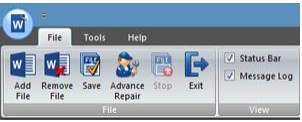
Figure 4 - File Menu
In Save Document dialog box that appears, do the following:
Select default location or a new folder to save the repaired file.
Save the file in any of these formats: ‘Full Document’, ‘Filtered Text’ or ‘Raw Text’.
Click OK.
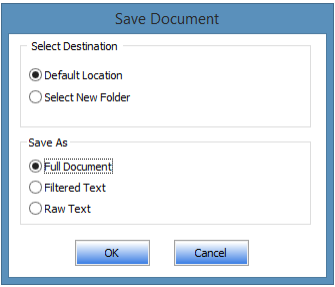
Figure 5 - Word Document Saving Options
The repaired file will be saved at your preferred location.
Steps to Repair Excel – .xls/.xlsx files
- In Select File window, click Browse to select the corrupt Excel file from the desired location. If you do not know the file location, click Search to find and select the corrupted spreadsheet.
- Once the Excel file is selected, start repairing the file by clicking the Repair button.

Figure 6 - Illustrates selection of one xls/xlsx file or multiple files in a folder
- After completion of the repair process, the software displays the repaired Excel file and its recoverable data in a preview window.
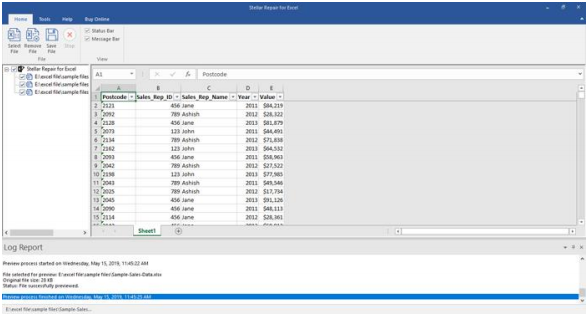
Figure 7 - Preview of Excel File
- Click on Save File icon on Home menu to save the repaired file.
- In Save File dialog box, choose Default location or Select New Folder for saving the file.
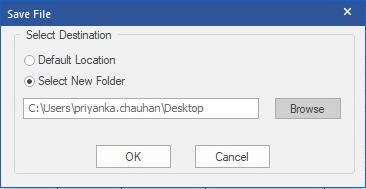
Figure 8 - Select Destination to Save Repaired Excel File
- Click OK to proceed with the saving process.
The repaired file gets saved at the preferred location.
Note: To recover the Engineering formulae, include ‘Analysis ToolPak’ Add-in.
Steps to Repair PowerPoint – ppt/pptx/pptm file
- Click Browse to select the corrupt PowerPoint file. Alternately, click on Search to search for the file, if the location is not known.
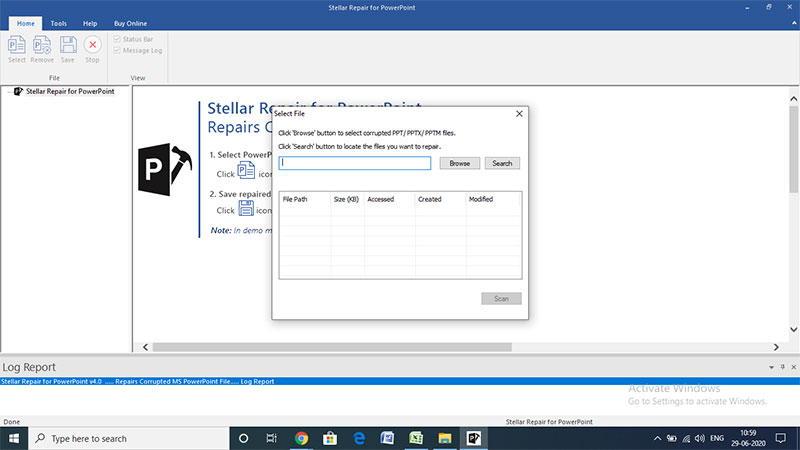
Figure 9 - Illustrates Selection of Single PowerPoint Presentation
- Once the corrupt PowerPoint file is selected, click Scan for scanning and repairing the file.
- A preview of scanned file gets displayed. Verify the file contents from the preview window.
- Click Save on Home menu to save the repaired PPT file.
- From the Save File dialog box, click Default location or Other location under Save As for saving the file.
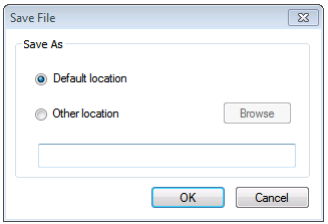
Figure 10 - Select Location to Save PPT File
- Click on the OK button and the repaired file is saved at preferred location.
Steps to Repair PDF file
- From the Stellar Repair for PDF main interface window, click Add File to select a single or multiple PDF files you want to repair.
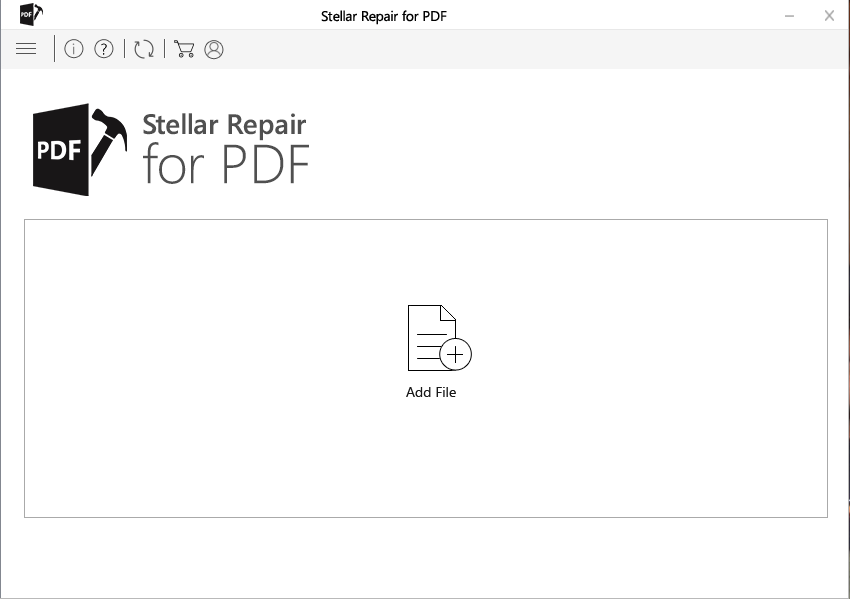
Figure 11 - Illustrates adding of corrupt PDF Files
- A screen with recently added PDF file is displayed. Select the file and click Repair to start repairing it.
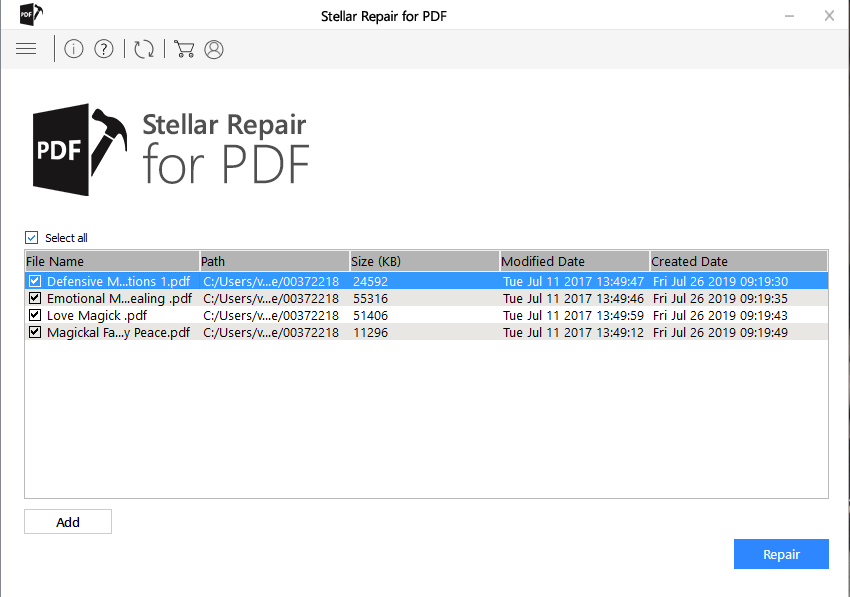
Figure 12 - Repair the Selected PDF File
- A screen showing the progress of the repair process appears.
- When the ‘Repair Complete’ window pops-up, click OK.
- Preview the repaired PDF file.
- Click the Save Repaired Files button to save the repaired file.
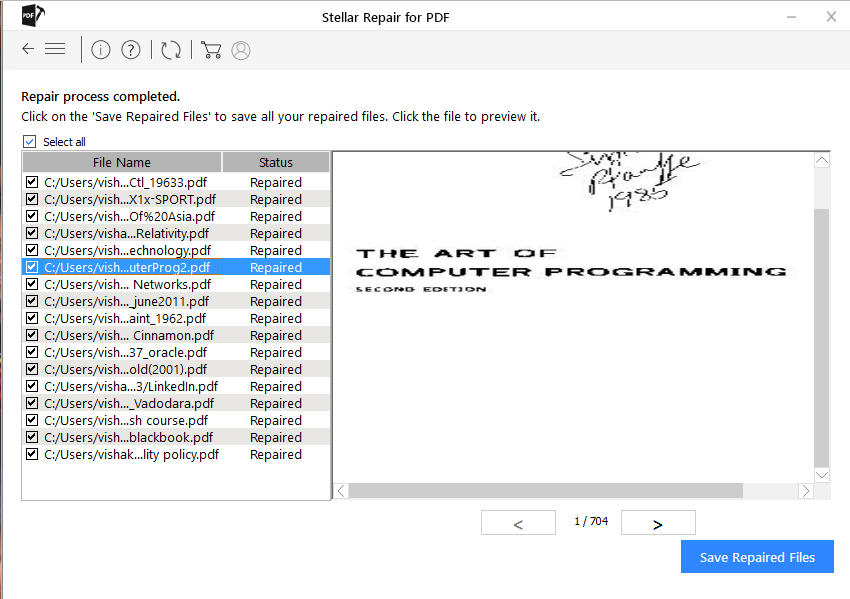
Figure 13 - Save Repaired File
- In Browse for Folder dialog box, select a folder for saving the file.
- From the Saving Complete dialog box, click the hyperlink to the folder containing the repaired PDF file.
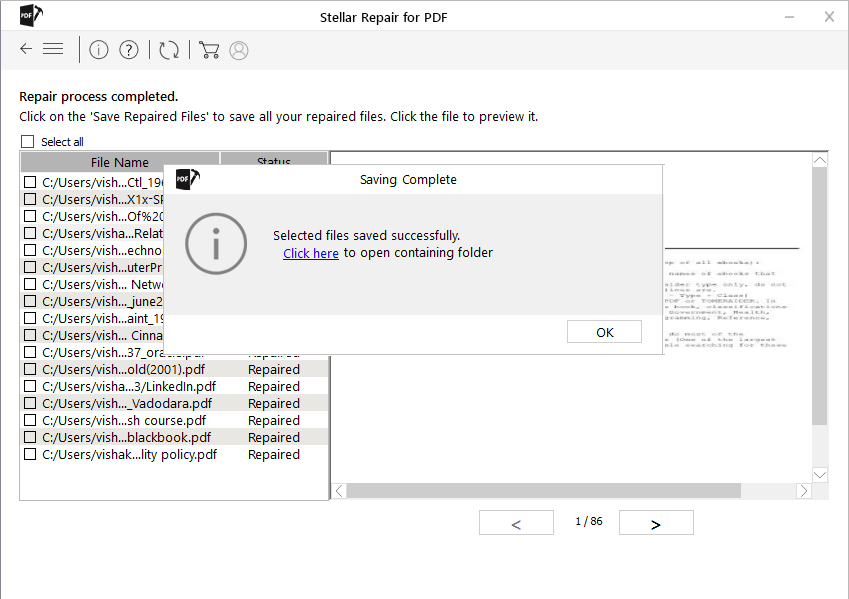
Figure 14 - Saving Complete Window
- Click OK.
[Fixed] Excel PivotTable Overlap Error | Troubleshooting Guide
In Excel, you need to refresh the pivot table data source after adding new data. However, sometimes, while refreshing the pivot table, you may experience an error “PivotTable Report cannot Overlap.” This issue usually appears when there are multiple pivot tables in a single worksheet. It often occurs when you try to place one pivot table on top of another or if you try to set a common cell range to multiple pivot tables. However, there are many other causes associated with the error.
Reasons for a pivot table report cannot overlap another pivot table report issue:
- Merged cells in a pivot table may cause the overlap issue
- Using the same range of cells for multiple pivot tables
- Hidden columns
- Preserve formatting option is enabled
- Modifying the pivot table using a macro that is corrupted
- Using the workbook.RefreshAll method incorrectly
- Number of pivot items goes beyond the number of cells available
- Excel file is corrupt
- Corrupted Pivot table
- Some columns are labeled with the same name
Methods to Fix Excel PivotTable Report Cannot Overlap Error
You can get the pivot table overlapping issue if the field in pivot table crossed the maximum items limit. According to the Microsoft guide, you can specify up to 1,048,576 items to return per field. Check the cell fields in your pivot table. Also, make sure each column’s label is unique. Sometimes, the hidden columns or hidden sheets can also prevent you from modifying the pivot tables. You can check for hidden columns in the Data view.
If the error still persists, then try the below-mentioned methods to fix the error.
1. Move the Pivot Table to a New Worksheet
The “PivotTable Report cannot Overlap” error can occur if there is an issue with the columns in the pivot table. In this case, you can try moving the pivot table to a new worksheet. Moving the pivot table to a different worksheet automatically resets the column width according to the new sheet and creates space that can help in preventing the overlapping issue. Here are the steps to do so:
2. Disable the Background Refresh Option
When the background refresh option is enabled, then Excel updates the pivot table in the background after every minor change. It may create issue if you have a large-sized Excel file with multiple pivot tables. You can try disabling the background refresh option. Here’s how:
The Connection Properties dialog box is displayed. Unselect the “Enable background refresh” option and select the “Refresh data when opening the file”
Click **OK.

**
3. Disable Autofit Column Widths
When the Autofit column widths option is enabled, Excel automatically resizes the pivot table whenever you make changes to it. These automatic adjustments can sometimes add or remove fields which can result in the PivotTable Report cannot Overlap issue. To fix this, you can disable the “Autofit column widths on update” option. To do this, follow these steps:
Right-click on any field on the pivot table.
Select **PivotTable Options.

**
In the PivotTable Options window, unselect Autofit column widths on update.

- Click on the OK.
4. Check the Workbook.RefreshAll Method
Several users have reported experiencing the “Excel PivotTable Report cannot Overlap” error when using the Workbook.RefreshAll method. This method is used to refresh data ranges in the pivot report. Sometimes, the error can occur due to missing variable that is representing an object (workbook) in a query. So, make sure you’re using the Workbook.RefreshAll function correctly.
5. Repair your Excel File
You may also encounter the “A PivotTable Report cannot Overlap” error if the Excel file is corrupted. You can use the inbuilt utility in Excel - Open and Repair to repair the corrupt file. Here’s how:
- In your Excel application, click on the File tab and then click Open.
- Click Browse to select the desired file.
- In the Open dialog box, click on the corrupted file.
- Click on the arrow next to the Open button and then click Open and Repair.
- Click on the Repair
- In the displayed message, click Close.
If the “Open and Repair” utility fails to fix the issue, then it means there is high level of corruption in the Excel file. To tackle this, you can take the help of a professional Excel file repair tool, such as Stellar Repair for Excel. The tool can easily repair severely corrupted Excel file and recover all the objects of the file, such as pivot tables, macros, charts, etc. with 100% integrity. You can download the free trial version of the tool to check its functionality.
Conclusion
In this article, we have discussed the possible reasons behind the “PivotTable Report cannot overlap” error in Excel. You can follow the methods mentioned above to fix the issue. The error may also occur if the Excel file gets corrupted. In this case, you can try repairing the corrupted Excel file using the Open and Repair utility or consider using Stellar Repair for Excel . The tool makes the process of repairing the Excel file smooth and quick.
How to Resolve ‘Excel found unreadable content in filename.xlsx’ Error in MS Excel?
When opening an Excel spreadsheet in MS Office 2010/2007, you may get the following error message:
“Excel found unreadable content in ‘[filename].xlsx’. Do you want to recover the contents of this workbook? If you trust the source of this workbook, click Yes.”

On clicking ‘Yes’, you may face any of these scenarios:
Note: If you choose to click ‘No’, then open your MS Excel application and click file > Open. When the Open dialog box opens, browse and select the file showing the ‘Excel found unreadable content’ error and then choose ‘Open and Repair’ option. If this didn’t help, try using a third-party Excel repair tool to save time troubleshooting the issue and restoring the file with all its data intact.
Scenario 1: The following message may pop-up.
“Excel was able to open the file by repairing or removing the unreadable content. Excel recovered your formulas and cell values, but
. Click to view log file listing repairs errorxxx.xml.”
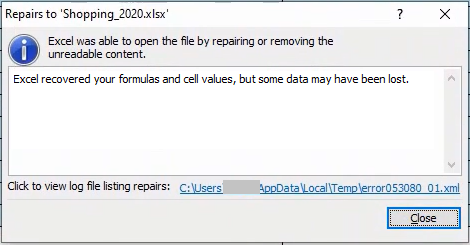
The message clearly states that your Excel file might open, but images may be lost and other such inconsistencies can crop up.
Scenario 2: The error is followed by another error message, like “The file is corrupt and cannot be opened“.
Watch our short video for a quick overview of the solutions to fix “Excel found unreadable content in filename.xlsx”
What Causes ‘Excel Unreadable Content’ Error?
You may encounter the ‘Excel file unreadable content’ error due to corruption of complete Excel file or corruption in certain areas (like Pivot Table, Formulas, Styles, or other objects) in the file. According to Microsoft, you may find it difficult to determine the root cause behind Excel file corruption. Corruption could occur in different scenarios, like power surge, a network glitch, copying and pasting corrupted data from another file, etc.
Also Read: How to recover data from corrupt or damaged Excel file 2010 & 2007?
Workarounds to Resolve the ‘Excel found unreadable content in filename.xls’ Error
There is no permanent solution to fix the ‘Excel found unreadable content’ error. But, following are some workarounds you can try to resolve the error.
Note: Before you try any of these workarounds, run Excel with administrator privileges and try opening the Excel file that is throwing the ‘unreadable content’ error. If this doesn’t fix the error, proceed with the workarounds below.
Workaround 1 – Try Opening the File in Excel 2003
Sometimes a problem in the current Excel version might prevent a file from opening. To resolve this error, try opening the problematic file in Excel 2003. If the file opens, save the data in a web page file format (.html) and then try opening the .html file in MS Excel 2010/2007. The detailed step-wise instructions are as follows:
- Open the .xls file in Excel 2003.
- When the file opens, click on File > Save.
- In the ‘Save As’ dialog box, choose Web Page (.html) as the ‘Save as type’ and then click ‘Save.’ Doing so will save everything from your .xls file, opened with 2003, in .html file format.
- Open the .html file in Excel 2010/2007. And then, save the file with .xlsx extension with a new name to avoid overwriting the original file.
Now, open the Excel 2010/2007 file and check if the error is fixed. If not, use the next workaround.
Workaround 2 – Make the Excel File ‘Read-only’
Try to open your ‘.xlsx’ file by making it ‘read-only’. Follow these steps:
- In Excel, click ‘File’ from the main menu.
- Select ‘Save’ for a new document or ‘Save As’ for a previously saved document in the screen that appears.
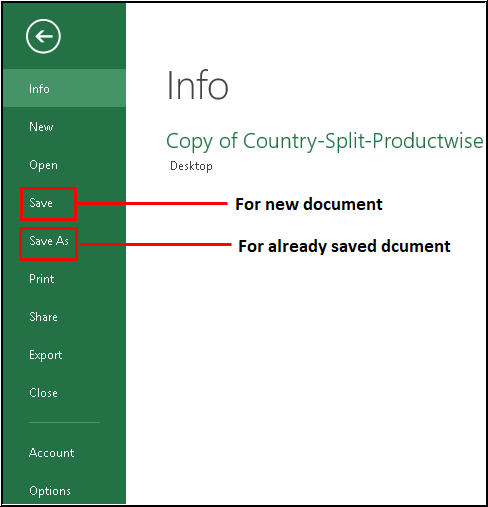
- From the ‘Save As’ dialog box, click Tools > General Options.
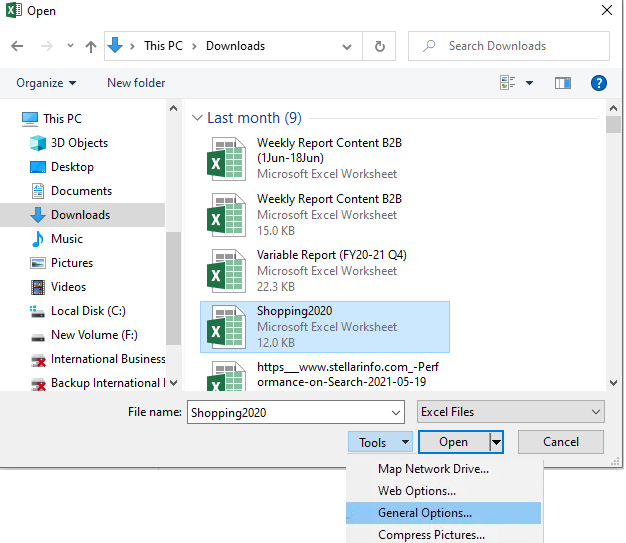
- Click on the ‘Read-only recommended’ checkbox to make the document read-only and then click ‘OK’.
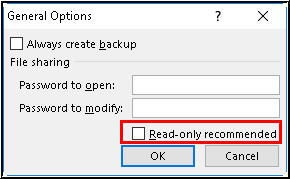
Now open a new ‘.xlsx’ file and copy everything from the corrupt Excel file to this new file. Finally, save this file and try to open it again.
Workaround 3 – Move Excel File to a New Folder
Some users have reported that they could open their Excel file, following the ‘Excel unreadable content’ error, by simply moving the file to a different folder and saving it under a new name. You can also move the affected file to a new folder and try opening it. If this didn’t help resolve the error, follow the next workaround.
Workaround 4 – Install Visual Basic Component
At times, it is seen that installing the ‘Visual Basic’ component of MS Office 2010 resolves the ‘Excel found unreadable content 2010’ error. To do so, follow these steps:
- Navigate to Control Panel > Programs and select Microsoft Office 2010.
- Click ‘Change’ and then select ‘Add or Remove Programs’.
- Next, click the ‘plus’ sign provided next to Office Shared Features.
- Click ‘Visual Basic for Applications’. After that, right-click and choose ‘Run from My Computer’ and hit the ‘Continue’ button.
- Reboot your system when this process finishes.
Now check if the issue has been resolved or not.
What Next?
If none of the workarounds mentioned above works for you, use a professional Excel repair software, such as Stellar Repair for Excel. The software repairs corrupt MS Excel sheets without modifying their original content and formatting. In addition, it can repair single or multiple Excel (XLS/XLSX) files in a few simple steps.
Steps to Repair Corrupt Excel File using Stellar Repair for Excel Software
Install and run Stellar Repair for Excel software.
From the software main interface window, click ‘Browse’ to select the corrupt file. If you are not aware of the corrupt Excel file location, click on the ‘Search’ button.
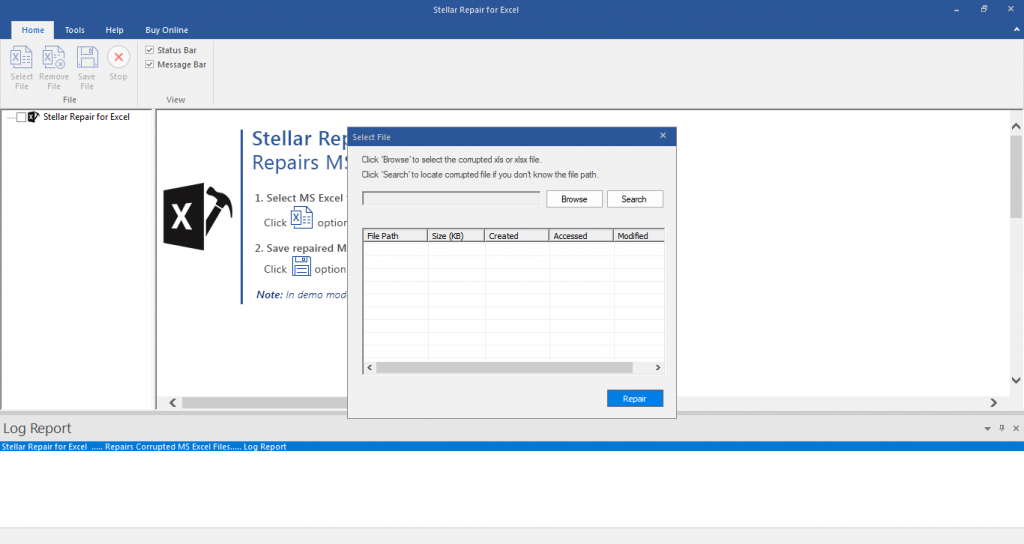
- Click on the ‘Repair’ button to scan and repair the selected file.
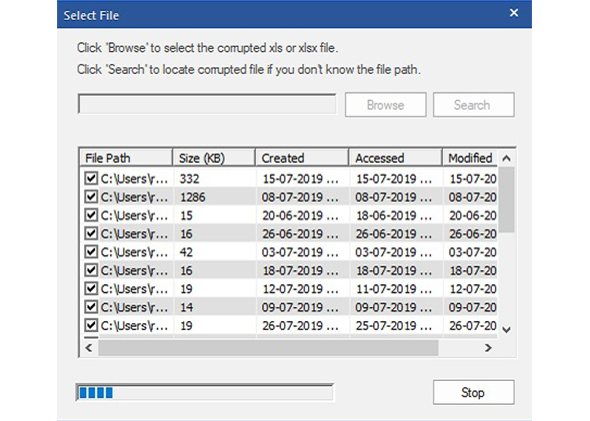
- A preview window will open with recoverable Excel file data. Once satisfied with the preview result, click on the ‘Save File’ button on the ‘File’ menu to start the repair process.
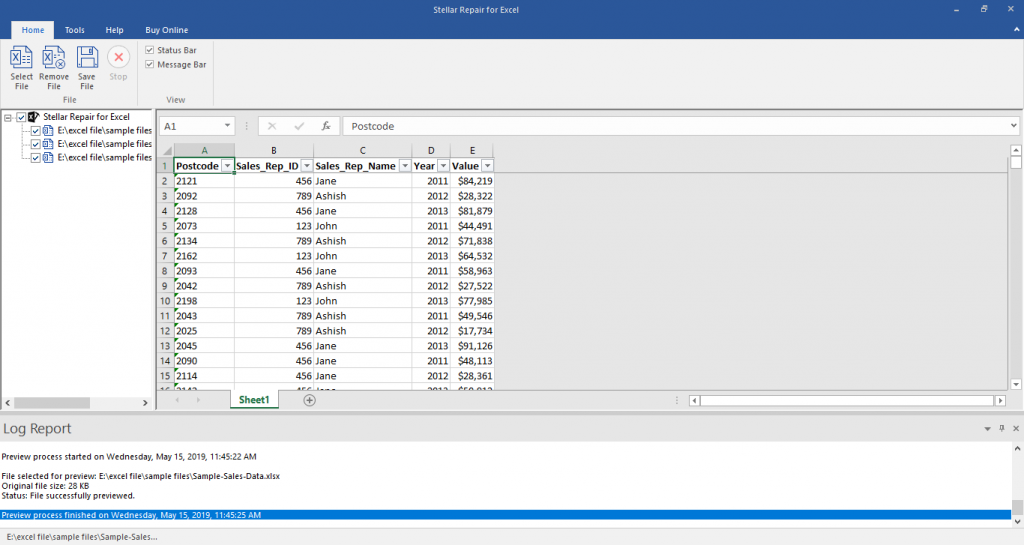
- Select the destination to save the file.
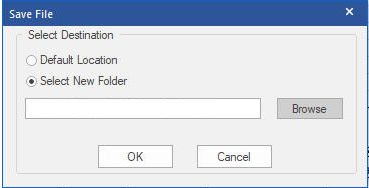
- Click ‘OK’ when the ‘Repaired file saved successfully’ message appears.
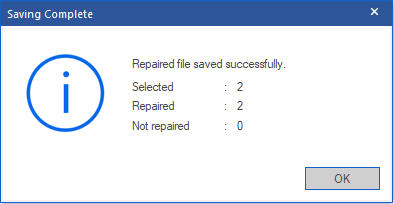
The repaired Excel file will get saved at the selected location.
Also read:
- [New] 2024 Approved 5 Innovative Apps to Design Stunning Openings
- [New] 2024 Approved Crafting Chorus in a Click Essential Insights Into Shortform Song Videos
- [New] 2024 Approved Secure Again Combating 2023'S Facebook Vulnerability
- [New] In 2024, Adding Videos to Written Work A Budget-Friendly Way
- [Updated] In 2024, Perfect Moment for Podcast Debuts
- All Things You Need to Know about Wipe Data/Factory Reset For Vivo G2 | Dr.fone
- How to Perform Hard Reset on Motorola Moto G 5G (2023)? | Dr.fone
- In 2024, PixelPilot Studio Plus Advanced OS Recorder
- In 2024, Top 10 Password Cracking Tools For Infinix GT 10 Pro
- Remove Google FRP Lock on Tecno Spark 20
- Simple ways to get lost messages back from Realme
- Solutions to restore deleted files from ZTE
- Troubleshoot Non-Functional Shift in Windows
- Undelete lost messages from Tecno
- Update NVIDIA RTX 2070 Super GPU Drivers - Easy Guide for Windows 10 and 11 Devices
- Title: Ways to Fix the Failed to Parse the Corrupted Excel 2023 File Error | Stellar
- Author: Ian
- Created at : 2024-10-28 11:39:19
- Updated at : 2024-11-03 19:41:56
- Link: https://techidaily.com/ways-to-fix-the-failed-to-parse-the-corrupted-excel-2023-file-error-stellar-by-stellar-guide/
- License: This work is licensed under CC BY-NC-SA 4.0.


